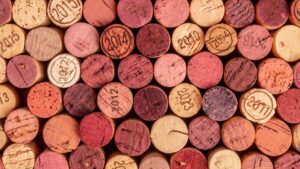Let’s face it, red and white are the most commonly encountered colours when it comes to wine. That said, it also comes in shades of rosé, grey, orange and even… yellow! Just like any other type of wine, Vin Jaune owes its – atypical – colour to its winemaking process. Let’s head to the Jura region in eastern France to unravel the secrets of Vin Jaune.

HOW IS VIN JAUNE CRAFTED?
Vin Jaune is an AOC (protected desisgnation) that can only be used in the Jura terroir. Vins Jaunes fall into the category of vins de voile (French for veil wines), which includes wines such as Sherry. The wine is aged in oak barrels for several years without topping. Topping is the technique that consists in refilling the barrels with more wine as the wine naturally evaporates (this is poetically referred to as the angels’ share) to compensate for the loss and keep the wine from oxidising. To produce Vin Jaune, winemakers deliberately allow a thin layer of yeast called voile, or veil to form on contact with the air.
Typically, wines are matured in a reductant environment (fully or almost fully) shielded from exposure to air to prevent the development of acetic pitting. The art of producing Vin Jaune consists in allowing a micro-organism (saccharomyces cervisiae) to develop on the surface of the wine. This means Vin Jaune is produced in contact with air in an oxidative environment. But this veil will protect the wine from being completely oxidised… This is called sous voile ageing in France. And it is a really delicate balancing act!
THE GOLDEN RULES OF VIN JAUNE
In addition to being a highly atypical and completely unconventional wine, Vin Jaune is also very strictly regulated. This wine is produced exclusively on four appellations, namely: Arbois, Côtes du Jura, Château-Chalon and l’Étoile Vin Jaune represents only 3.5% of the production of Jura wines. It is produced from a single authorised white grape variety called Savagnin. By law Vin Jaune must be aged for a minimum of 6 years and 3 months before it can be bottled. Once this unconventional maturing period is complete, the Jura villages come alive with the increasingly popular Percée du Vin Jaune ceremony. This festive gathering is a celebration of the first barrel being tapped and the release of a new vintage. It takes place annually on the first weekend of February.
As we just explained, achieving such a level of controlled oxidation is a real challenge. The barrels used are several years old and generally sourced in neighbouring Burgundy. The wines are neither treated with sulphites nor racked to encourage the development of the desired yeast. Unfortunately, it is not uncommon for the yeast veil to tear. When this happens, the entire barrel is set aside… And once bottled the wine, generally blended with Chardonnay, is marketed under the broader Côtes du Jura AOC. This wine is typically referred to as Tradition cuvées, as is the case at Domaine Jean Macle.
THE CLAVELIN
Vin Jaune is traditionally bottled in a smaller size vessel called clavelin (a name derived from the English bottle used by wine merchants in the 18th century) with a capacity of 620ml. This unusual bottle has survived the test of time in the Jura region for good reason. Each litre of wine left to mature in a wooden barrel for 75 months, results in 620ml of liquid gold… mirroring the capacity of the clavelin.
CHÂTEAU-CHALON THE FINEST YELLOW ELIXIR IN JURA
Château Chalon is indisputably the premier AOC for the production of Vin Jaune. As a matter of fact, Vin Jaune is all this appellation produces. Located at the foot of one of France’s most beautiful villages, on a rocky peak, lies a tiny 60-hectare vineyard. Here, the soil consisting of blue and black marl imparts extra depth to the wine.
Some of the greatest producers of Château Chalon include Stéphane Tissot, Jean Macle and Overnoy. Among the estates that have become part of history, Marius Perron’s wines now rank among the most sought-after in the Jura region.
HOW TO ENJOY VIN JAUNE
Vin Jaune offers a remarkably powerful aromatic strength. To taste Vin Jaune is like entering an entirely different realm. Like exploring a different category of wines altogether. The prevailing aroma on the nose and in the mouth is green walnut, combined with green apple or spices. In a nutshell, it’s a truly magical wine, with the ability to defy the years like no other. Trust us when we say that a vertical tasting of Macle wines is a truly unique experience. At the same time, Vin Jaune leaves no one indifferent. You either really love it or you absolutely loathe it. We suggest you try a Tradition cuvée first, to gauge whether you like oxidative wines or not. This wine is both more supple and more accessible than the traditional Vin Jaune.
When it is served with food, the power of Vin Jaune is such that it can upset the balance of many dishes… Although it can also make for magical pairings, especially with regional produce. Comté with very long maturing periods obviously springs to mind. This cheese paired with Vin Jaune makes for a match made in heaven, and one that is as obvious as they get!
Then, there’s the neighbouring Bresse region, the land of the famous Bresse Poulard (bred for 5 months, it’s a plumper version than the Bresse Chicken that’s just as delicious). When cooked in Vin Jaune with local mushrooms – more specifically morels – it naturally calls for the same wine to be poured at the table. Another indulgence is to add a ‘splash’ of Vin Jaune when baking a whole Mont d’Or (French cow’s milk cheese). A recipe that’s guaranteed to be a hit.
And, for the more adventurous, Asian cuisine with curry or turmeric is another great pairing. These notoriously wine-averse spices will finally meet the perfect match for their incredibly complex aromas!



